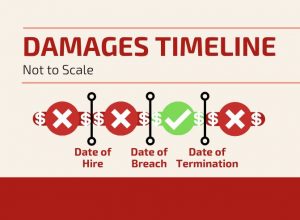At-Will Employment: How Are Job Positions Valued?
January 29, 2021
Unauthorized use and/or duplication of blogposts without express and written permission is strictly prohibited. Excerpts and links may be used, provided that full and clear credit is given, and with appropriate and specific direction to the original content.
The author of this post can be reached by phone at 206-693-2718 or by email.
Some Employment Roles Have Value Beyond Wages: A Cornerpoint Case Pop
By Stacia Hofmann
Cornerpoint Case Pops are dedicated to summarizing relevant, new cases — and their business and risk management lessons — in bite-size posts.
Last month, I posted an alert that employers who use written employment offers and unilaterally and materially change promised job duties after employment begins may face breach of contract claims. The post followed on the heels of a recent Washington appellate court decision concerning a newly-created executive role at the Bill & Melinda Gates Foundation. The judges decided that the law and the facts supported an employee’s allegations that his position did not materialize as promised, and that the Foundation was therefore liable for breach of contract.
In this supplementary post, let’s look at what money damages were owed by the Foundation to the employee because of the Foundation’s breach.
The Case: Bill & Melinda Gates Foundation v. Pierce, Washington Court of Appeals, Division I, No. 79354-3-I (November 16, 2020)
Case Background
The facts of the case are summarized in more detail here. For purposes of this post, the following facts and findings are important:
- The employee left his current job, salary, and stock options to join the Foundation as Chief Digital Officer (CDO).
- The Foundation and employee exchanged a written employment offer, which everyone agreed was a binding contract.
- Employment was at-will, meaning that there was no agreement that employment would last a certain amount of time.
- The trial judge found that in November 2015, about six months into employment, and after a disagreement between the employee and the Foundation, the Foundation actively prevented the employee from fulfilling the CDO role.
- The Foundation terminated the employee quite a bit later — in October 2016.
- The appellate court agreed that, in November 2015, when the Foundation stopped providing the employee with the broad digital strategy job he was promised, the Foundation breached the employment offer.
Since Employment Was At-Will, What Were the Employee’s Damages?

.
It was not enough that the employee proved that the Foundation failed to fulfill its promises and breached the contract. The employee also had to convince the judges that the failure caused him damages. But since employment was at-will, what damages did the employee sustain? How could the damages be measured?
Future Earnings? The judges considered the employee’s future earnings from the Foundation had he not been terminated. But the parties did not agree for the employee to be employed for any set amount of time. So future earnings from the Foundation were not recoverable damages.
Higher Salary and Forfeited Stock Options From Prior Employer? The judges considered the employee’s higher salary and the value of stock options that the employee forfeited from his previous job when he took the job at the Foundation. But the prior salary and stock options would have been forfeited even if the Foundation had not breached its contract. There was no cause and effect. So the value of the pre-Foundation salary and forfeited stock options were not recoverable damages.
Foundation Salary? The judges considered whether the employee could recover his wages from the Foundation during the time of his employment. But during employment, the employee was paid the wages he was promised, so he did not sustain any direct financial loss in his paychecks. So his wages were not recoverable damages.
Value of the CDO Position? For 11 months (November 2015 through October 2016), the employee was working in a job that was not what he was promised. Thus, the judges concluded that the proper measure of damages was the difference in value between the CDO position that the employee was promised versus the position in which he was instead relegated. Put another way, the employee’s marketability, skills, and reputation may have been damaged during those 11 months, since he was not performing CDO duties.

The above timeline shows when the employee’s damages should be measured. If this all seems imprecise to you, the judges would agree. They even acknowledged that the damages were “ephemeral,” but experts could be called in to testify about comparable employment opportunities, the specialized CDO role, and how much monetary value the role would hold at a place of employment as prestigious as the Foundation. The appellate judges sent the case back to the trial judge.
Key Takeaway
I don’t know the value of a CDO position at the Foundation, but I do know that going through litigation, a trial, an appeal, and a remand is incredibly expensive. Small employers need to understand that at-will employment is not an insurance policy against employee claims. An employment offer that overpromises or is not well-drafted can be just as risky, if not more so, than having no employment offer at all.
Email or call me to see if Cornerpoint can help with your questions about employment offers and contracts.
This blog is for informational purposes only and is not guaranteed to be correct, complete, or current. The statements on this blog are not intended to be legal advice, should not be relied upon as legal advice, and do not create an attorney-client relationship. If you have a legal question, have filed or are considering filing a lawsuit, have been sued, or have been charged with a crime, you should consult an attorney. Furthermore, statements within original blogpost articles constitute Stacia Hofmann’s opinion, and should not be construed as the opinion of any other person. Judges and other attorneys may disagree with her opinion, and laws change frequently. Neither Stacia Hofmann nor Cornerpoint Law is responsible for the content of any comments posted by visitors. Responsibility for the content of comments belongs to the commenter alone.




